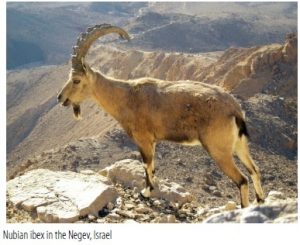 The Mishna (26b) teaches that the shofar blown in the Temple on Rosh HaShana was made from the horn of a ya’el (ibex) and its mouthpiece was covered with gold. When it was sounded it was accompanied by hatzotzrot – trumpets – on either side, although the sound of the trumpets was shorter than that of the shofar, since the mitzva of the day was the shofar. On fast days the hatzotzrot were in the middle surrounded by shofarot, and in this case the sound of the shofar was shorter, since the mitzva of the day was the trumpet.
The Mishna (26b) teaches that the shofar blown in the Temple on Rosh HaShana was made from the horn of a ya’el (ibex) and its mouthpiece was covered with gold. When it was sounded it was accompanied by hatzotzrot – trumpets – on either side, although the sound of the trumpets was shorter than that of the shofar, since the mitzva of the day was the shofar. On fast days the hatzotzrot were in the middle surrounded by shofarot, and in this case the sound of the shofar was shorter, since the mitzva of the day was the trumpet.
The ya’el, whose horns were used to fashion shofarot, is identified as Capra ibex nubicum, an animal that lives in small herds mainly in mountainous areas and in the desert if there is water readily accessible (like in the area of the Dead Sea and nearby Ein Gedi).
The Temple hatzotzrot are readily viewed on the Arch of Titus in Rome, which depicts the Judean captives transporting the Temple vessels to Rome.
 One of the concerns of our Gemara is how the mouthpiece could have been covered with gold. This question is understood differently by the various commentaries. Some explain that the assumption of the Gemara was that a band of gold was placed around the edge of the shofar and the problem stemmed from the rules of hatzitza– that the person’s mouth was not directly in contact with the shofar when it was sounded. Others suggest that the case would have been where an additional mouthpiece was attached to the shofar so that the person blowing it was not directly in contact with the shofar, but rather he was blowing it through the use of a foreign object. In response to this objection, Abaye explains that we must be talking about a situation where the gold was placed as a decoration further up on the shofar, above the spot where the lips of the person blowing came into contact with the shofar.
One of the concerns of our Gemara is how the mouthpiece could have been covered with gold. This question is understood differently by the various commentaries. Some explain that the assumption of the Gemara was that a band of gold was placed around the edge of the shofar and the problem stemmed from the rules of hatzitza– that the person’s mouth was not directly in contact with the shofar when it was sounded. Others suggest that the case would have been where an additional mouthpiece was attached to the shofar so that the person blowing it was not directly in contact with the shofar, but rather he was blowing it through the use of a foreign object. In response to this objection, Abaye explains that we must be talking about a situation where the gold was placed as a decoration further up on the shofar, above the spot where the lips of the person blowing came into contact with the shofar.
You must be logged in to post a comment.